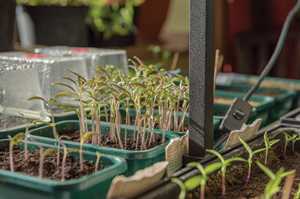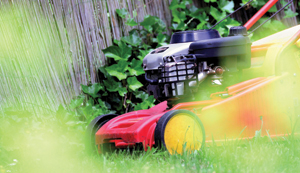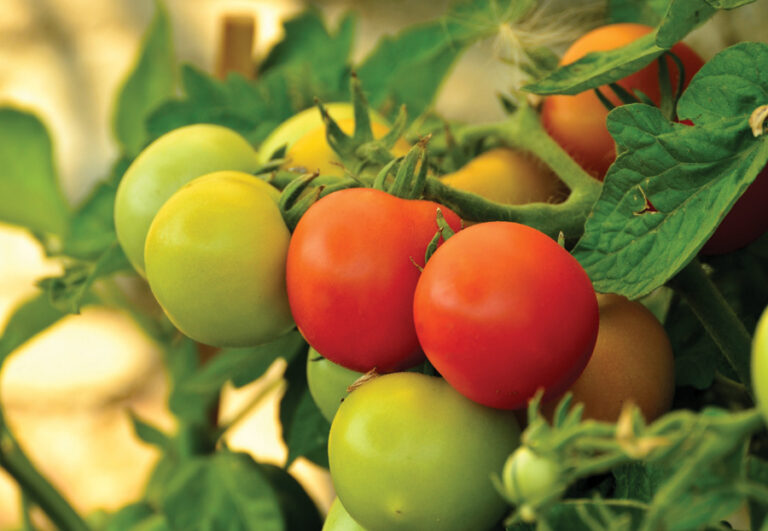This is a month of positivity for just about everyone, not just gardening folk. There might be winds that feel gusty enough to blow off your gardening boots or perhaps there will be sunshine to fix the widest of smiles firmly in place for a month of scurrying and secateurs. Whatever the weather, get outside and enjoy the arrival of spring.
Meteorologically speaking, this happens on the first of the month, or astronomically on 20 March this year. Weather folklore suggests that if it comes ‘in like a lion’, it should go ‘out like a lamb’, so be prepared for anything. Daylight hours are growing longer and warmth will be coming soon, whatever the weather at the moment. Even if you don’t feel it yet, your plants outdoors are awakening and about to enjoy a vibrant growth spurt.
There’s no time to waste if you want to prepare for the growing season. There are plenty of opportunities for rewarding tasks, including within the kitchen garden and allotment.
 The kitchen garden
The kitchen garden
If you’re lucky enough to have a greenhouse, you can sow seeds such as tomatoes, aubergines, cucumbers, gherkins, sweet peppers and celeriac. Some will need the encouragement of a propagator. Sowing seeds early means that some won’t make it, particularly if there is a cold snap. But it’s worth keeping an eye on weather forecasts and giving them extra protection when required. Your crops will be bountiful this season if you can get a head start! The soil in the allotment garden can be prepared by removing weeds and covering it with some sort of matting, which will not only stop more weeds from growing but will also warm the soil.
From mid-March onwards, vegetables such as summer cabbage, Brussels sprouts, leeks, onions, carrots, broad beans, spring onion and beetroot can be sown outdoors under a cloche. Perennial herbs including rosemary, oregano, sage and thyme can also be sown under cover.
You might already have chitted (or sprouted) early seed potatoes as this can commence from late January onwards, depending on where you live. Potatoes need up to six weeks of chitting before planting when soil temperatures are around eight degrees, so some might be ready to go into the ground during March. Potatoes probably won’t do well if they are planted in cold or waterlogged soil, so it’s best to wait until temperatures rise. Don’t forget that you can plant them into bags rather than the ground if space is at a premium. This also allows you to move the bags into a warmer and drier space during inclement weather.
If you don’t have a vegetable growing area, you could consider installing a raised bed or a freestanding growing table that stands on your sunny patio. It’s a great way to garden for all ages because it saves bending and stooping, and you can position it close to the kitchen for quick and easy access.
 Lawns and borders
Lawns and borders
March is a great month for the first cut of the lawn, provided the ground is not too wet and the weather is dry and frost-free. Set the mower blades high and give it a gentle trim to even out the length. It’s surprising what a difference it will make – particularly if you neaten up the edges too. A lawn always benefits from aeration and this can be as simple as pushing a garden fork down into the turf for as deep as you can manage, across the surface. A hollow tine aerator is a more sophisticated piece of equipment as each tine removes plugs of soil as it is used. These are deposited back onto the surface of the lawn. Poor drainage is the major contributor to moss growing within a lawn, together with deep shade. You need water to be able to seep away and the holes you add will aid this.
Consider adding your homemade compost to borders to act as a mulch. Remove weeds first, but take care not to trample the soil as this will squeeze away valuable air. Laying a board on the surface helps to distribute your weight evenly. This month is all about preparing the soil to create the best conditions for root health for trees, shrubs, perennials and edible plants.
Don’t forget to appreciate the colourful sights that this month brings. There are nodding daffodils, early tulips, crocus, hyacinths, pansies, primulas, snowdrops, wallflowers, and flowering shrubs including ribes, forsythia, viburnum and magnolia. Spring is in the air and our hearts can start to sing.
By Caroline Knight


